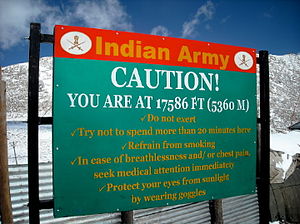Altitude sickness
Altitude sickness is the harmful effect of high altitude. The mildest form is known as acute mountain sickness (AMS)
| Altitude sickness | |
|---|---|
| Other names | High-altitude sickness,[1] altitude illness,[1] hypobaropathy, altitude bends, soroche |
 | |
| Altitude sickness warning – Indian Army | |
| Specialty | Emergency medicine |
| Symptoms | Headache, vomiting, feeling tired, trouble sleeping, dizziness[1] |
| Complications | High-altitude pulmonary edema (HAPE), high-altitude cerebral edema (HACE)[1] |
| Usual onset | Within 24 hours[1] |
| Types | Acute mountain sickness, high-altitude pulmonary edema, high-altitude cerebral edema, chronic mountain sickness[2] |
| Causes | Low amounts of oxygen at high elevation[1][2] |
| Risk factors | Prior episode, high degree of activity, rapid increase in elevation[2] |
| Diagnostic method | Based on symptoms[2] |
| Differential diagnosis | Exhaustion, viral infection, hangover, dehydration, carbon monoxide poisoning[1] |
| Prevention | Gradual ascent[1] |
| Treatment | Descent to lower altitude, sufficient fluids[1][2] |
| Medication | Ibuprofen, acetazolamide, dexamethasone, oxygen therapy[2] |
| Frequency | 20% at 2,500 metres (8,000 ft) 40% at 3,000 metres (10,000 ft) |
Causes change
It is caused by rapid exposure to low amounts of oxygen at high elevation.
Altitude change
The severity of the disorder is related to the speed of ascent and the altitude reached. These symptoms disappear when going to lower altitudes. It occurs from 2,500 meters in altitude, up to the so-called "death zone" at 7,500 meters in altitude.
Hypoxia change
The main cause is hypoxia (lack of oxygen in the body). Atmospheric pressure decreases with height, which affects the bio-availability of oxygen, since the pulmonary alveoli are not capable of transporting the same amount of oxygen to the blood as in a situation of higher pressure. Although it is known that hypoxia is the cause of this problem, the exact mechanism by which it causes it is still unknown.
The amount of oxygen available to sustain mental and psychological attention decreases as altitude increases. The availability of oxygen and nitrogen, as well as their density, decrease with increasing altitude.
Dehydration change
Dehydration due to accelerated loss of water vapor due to altitude can lead to symptoms of altitude sickness. The speed with which one ascends, the initial height, physical activity, as well as individual susceptibility are factors that contribute to this discomfort.
Prevention change
Altitude sickness can be prevented by climbing slowly. In most cases, symptoms are temporary and usually reduce as altitude acclimatization occurs. However, in extreme cases, altitude sickness can be fatal.
References change
- ↑ 1.0 1.1 1.2 1.3 1.4 1.5 1.6 1.7 1.8 Ferri, Fred F. (2016). Ferri's Clinical Advisor 2017 E-Book: 5 Books in 1. Elsevier Health Sciences. p. 590. ISBN 9780323448383.
- ↑ 2.0 2.1 2.2 2.3 2.4 2.5 "Altitude Diseases - Injuries; Poisoning". Merck Manuals Professional Edition. May 2018. Retrieved 3 August 2018.
Other websites change
Altitude sickness travel guide from Wikivoyage
| Classification | |
|---|---|
| External resources |
- "Travel at High Altitude: a free booklet about how to keep healthy at altitude. Available in many languages". Archived from the original on 2012-07-11.
- Merck Manual entry on altitude sickness
- Altitude Illness Clinical Guide for Physicians Archived 2006-10-18 at the Wayback Machine